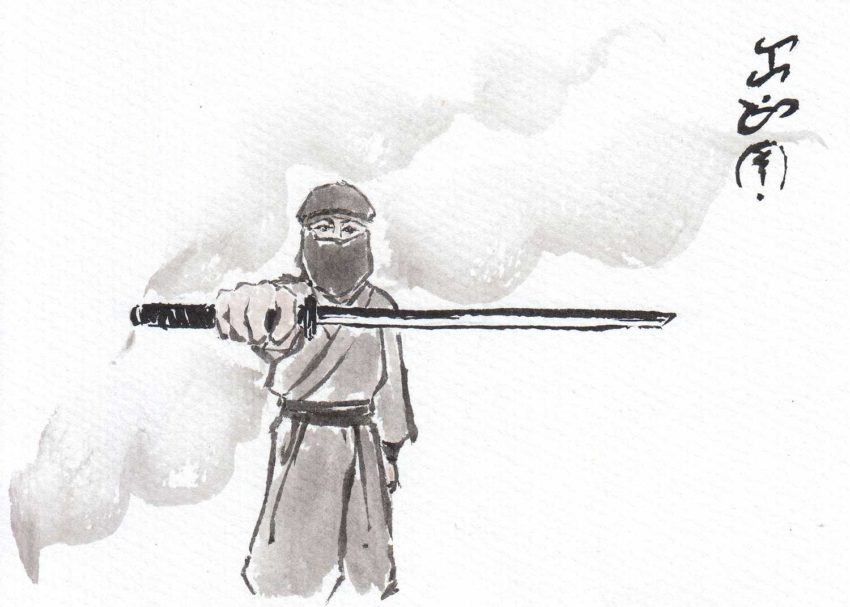What’s usually brought to mind when thinking of Japanese weaponry is the familiar image of a long, elegant blade with gentle curvature. Curved blades such as the katanaKATANA 刀 "sword" learn more... seem to embody samurai-era Japan in a way other blades do not. Samurai also fought with other curved weapons, such as the tachiTACHI 太刀 "great sword" learn more... or the kodachiKODACHI 小太刀 "small tachi sword" learn more.... Straight swords, by contrast, are more often associated with early Europe. However, straight swords were a part of Japanese weaponry. Although the Japanese straight sword does not feature as often in media, and although these blades are not as well known to the public, straight swords actually comprised a crucial part of early Japanese weaponry.
Chokuto Swords
Besides the curvature, a feature commonly associated with Japanese swords is the careful steel folding during the preparation of the billet. However, Japanese straight swords that preceded curved blades were made of unfolded steel. A Japanese straight sword represents the beginning of the blade craftsmanship that would develop over time. These swords were called chokutoCHOKUTO 直刀 "straight sword" learn more..., or “straight sword”. These were likely used during the early years of the Kofun era, which lasted from 300 AD to 538 AD.
Chokuto were useful for hacking and thrusting motions. They are believed to have been widely used by early Japanese infantry. Like many of the battle tactics employed by military leaders, chokuto were coarse but effective. As military strategies grew more sophisticated over time, blades continued to reflect the developing refinement of Japanese warfare. Straight swords were re-examined with an eye for further development; chokuto simply did not have the lethality desired in intense combat.
The fundamental techniques used to make the swords may have originated in early China because the straight blades resemble the ancient Chinese swords, such as the zhibedao of the Shang era. Other straight blades from the Kofun era were also used, such as the tsurugiTSURUGI 剣 "sword [non-Japanese]" learn more... sword. This sword actually resembles European blades. The production of tsurugi swords was also strongly influenced by ancient Chinese practices. It is thought to be a Japanese version of the Chinese jian sword.
Alternatives to the Japanese Straight Sword
The limited effectiveness of the chokuto was revealed when Mongol raiders invaded Japan several hundred years ago. The invading Mongols were sent by Kublai Khan, who was ultimately unsuccessful in conquering the territory. Despite that failure, the Mongols displayed superior skills with swords. Japanese warriors took note of the curved Mongol sabres used in attacks. These sabres were easy to use on horseback and could slice through armor.
Japanese soldiers also realized that their chokuto chipped when thrust into armor. The later years of the Kofun era saw the Japanese revamp their sword-making techniques. The hard chokuto blades, though sharp, were too brittle for heavy use. Softer blades, though durable, demanded time for frequent sharpenings. The steel of the edge of the blade was hardened, and steel for the back of the blade was allowed to remain soft. This method allowed the Japanese to make curved blades, which were eventually preferred over straight swords.
Still, there are other swords that play important roles in the history of Japanese straight swords.
Tanto Swords
The tantoTANTO 短刀 "short sword" learn more... blade was a Japanese straight sword used after the Kofun era. Tantos were used as weapons around the Heian era. These were short swords and not intended primarily for slashing movements; they were thought of as stabbing weapons. These swords were mostly straight, though exceptions began to develop over time. They were not used as primary weapons but were often complemented with longer blades.
Initially, tantos were used as weapons but were later designed as artistic objects. However, when heavy fighting broke out in Japan, during the Muromachi period of severe social upheaval, demand for tanto production increased. The need for quantity compromised the quality of the blades, though experienced craftsmen continued to make quality tanto swords.
After the wars, a calmer period began and there was a decreased demand for tantos as weapons. Tantos were still being forged just before World War II, and were occasionally used during the war. However, the conclusion of WW2 brought about a ban on sword making.
And so for a long time, tantos were not produced until Western interest in Japanese culture began to increase. It’s true that Westerners have helped create a market for tanto blades. Many Americans and Europeans buy modern tanto swords for their value as objets d’art. It’s undeniable that a Japanese straight sword looks great when it’s displayed properly.
The Swords of the Shinobi
Another Japanese straight sword that may mostly exist in folklore is the ninjatoNINJATO 忍者刀 "ninja sword" learn more... blade. This weapon is believed to be a relatively short straight sword favored by the ninja of feudal Japan. Ninjas conducted covert operations and other duties viewed as too unseemly for samurai warriors. The ninjato sword is believed to be one of the swords they were allowed to carry.
However, there is no material proof that this sword was ever actually manufactured, for any warrior class. The evidence pointing to its existence is so scanty that it is commonly thought of as a fictional weapon. Plenty of replicas or artistic impressions can either be found in Japanese museums or purchased from shops that sell Japanese-influenced merchandise. But it remains true that no genuine ninjato belonging to any era have been discovered.
There is however some evidence challenging the belief that ninjato swords are entirely fictional. A man named Okuse Heishichiro became the mayor of Japan’s Ueno City after serving as the Head of the Planning Department. He wanted to bring local tourism into the city, so he made significant contributions to how ninja soldiers were perceived by outsiders. He authored a booklet titled Ninjutsu which contained highly romantic descriptions of wars and rebellions. Many inaccuracies exist in these descriptions, so it is hard for the booklet to be taken seriously as a historical resource.
Tantalizingly, though, Okuse did include plenty of photographs in the booklet. The photographs depict saws, tools, and climbing devices supposedly used by the shinobi. One of the pictures is of a straight-bladed ninjato sword. This image challenges the idea that the sword is just fictional. The booklet also indicates that the ninjato was designed to be short enough for use inside houses.
Could this prove the existence of this particular Japanese straight sword? Although the booklet cannot be valued as a reliable scholarly document, it may in fact offer proof that the ninjato existed.
Japanese straight swords today
There are many Japanese straight swords on display at museums (and not just in Japan). There are also different replicas crafted for collectors to purchase. Chokuto swords from ancient periods tend to be fragile, so they are carefully displayed to show the length and shape of the blade. Modern replicas of these swords are also available.
A tsurugi sword is displayed at the Metropolitan Museum of Art in New York. Replicas of this particular kind of sword also exist, although they are not as popular or well known as other swords.
Tanto swords are easy to locate in both museums and in shops. They are prized for their historical value and for their artistic beauty. Tantos are exhibited at both the Japanese Sword Museum and in the British Museum. The blades are often displayed to reveal the ornate designs on the handle and on the sheath. Some older tanto blades have been discovered without handles or sheaths, so displays of these tanto blades emphasize the shape and edge of the billet. Brand-new, modern-day tantos are also custom made and sold to customers interested in traditional Japanese weaponry.

